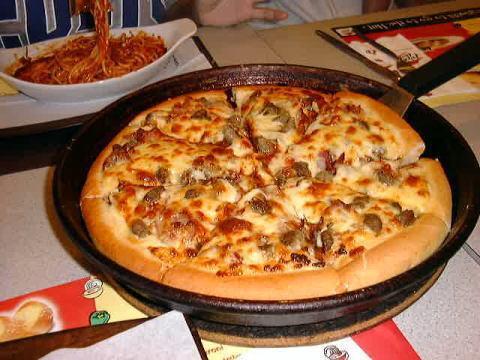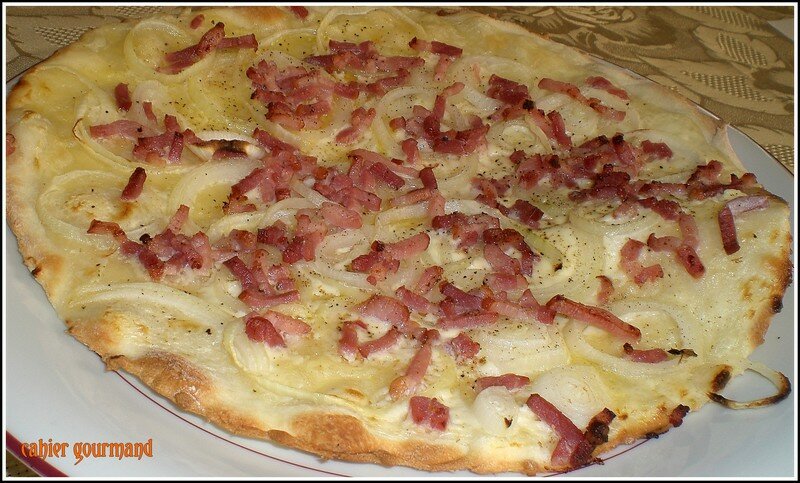SquiddyCracker
Banned
The history of Pizza
Pizza in its most basic form as a seasoned flatbread has a long history in the Mediterranean. Several cultures including the Greeks and Phoenicians ate a flatbread made from flour and water. The dough would be cooked by placing on a hot stone and then seasoned with herbs. The Greeks called this early pizza plankuntos and it was basically used as an edible plate when eating stews or thick broth. It was not yet what we would call pizza today but it was very much like modern focaccia. These early pizzas were eaten from Rome to Egypt to Babylon and were praised by the ancient historians Herodotus and Cato the Elder.
The introduction of tomatoes to Italian cuisine in the 18th and early 19th centuries finally gave us the true modern Italian pizza. Even though tomatoes reached Italy by the 1530's it was widely thought that they were poisonous and were grown only for decoration. However the innovative (and probably starving) peasants of Naples started using the supposedly deadly fruit in many of their foods, including their early pizzas. Since that fateful day the world of Italian cuisine would never be the same, however it took some time for the rest of society to accept this crude peasant food. Once members of the local aristocracy tried pizza they couldn't get enough of it, which by this time was being sold on the streets of Naples for every meal. As pizza popularity increased, street vendors gave way to actual shops where people could order a custom pizza with many different toppings. By 1830 the "Antica Pizzeria Port'Alba" of Naples had become the first true pizzeria and this venerable institution is still producing masterpieces.
Thanks to http://www.lifeinitaly.com/
Pizza, pizza, pizza - so much pizza!
Pizza is one of the most versatile foods out there, in addition to a near infinite combination of toppings, sauces, and cheeses - there are even different types of doughs and compositions:
Italian pizzas
Neapolitan pizza

Neapolitan pizza (pizza napoletana): Authentic Neapolitan pizzas are typically made with tomatoes and Mozzarella cheese. They can be made with ingredients like San Marzano tomatoes, which grow on the volcanic plains to the south of Mount Vesuvius, and mozzarella di bufala Campana, made with the milk from water buffalo raised in the marshlands of Campania and Lazio in a semi-wild state (this mozzarella is protected with its own European protected designation of origin).
Lazio style

Pizza al taglio

Pizza Rustica
Pizza in Lazio (Rome), as well as in many other parts of Italy, is available in two different styles. Take-away shops sell pizza rustica or pizza al taglio. This pizza is cooked in long, rectangular baking pans and relatively thick (1–2 cm). The pizza is often cooked in an electric oven. It is usually cut with scissors or a knife and sold by weight. In pizzerias, pizza is served in a dish in its traditional round shape. It has a thin, crisp base quite different from the thicker and softer Neapolitan style base. It is usually cooked in a wood-fired oven, giving the pizza its unique flavor and texture.
German pizzas
Flammkuchen

Flammekueche or Tarte flambée is an Alsatian dish composed of bread dough rolled out very thin in the shape of a rectangle (traditionally) or circle, which is covered with fromage blanc or crème fraîche, thinly sliced onions and lardons. It is one of the most famous gastronomical specialties of the region.
Brazilian pizzas
Pizza com catupiry
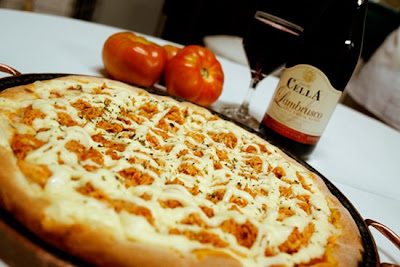
This pizza is unique to Brazil and "Catupiry", a type of creamy cheese, on the pizza.
Korea
Grand Prix

Korean-style pizza tends to be complicated, and often has nontraditional toppings such as corn, potato wedges, sweet potato, shrimp, or crab. The super-deluxe "Grand Prix" at Mr. Pizza has Cajun shrimp, bell peppers, olives, and mushrooms on one side, and potato wedges, bacon, crushed tortilla chips, and sour cream on the other side. Its potato mousse-filled cookie dough crust is sprinkled with sunflower seeds, pumpkin seeds, and raisins, and can be dipped in a blueberry sauce that is provided.
Sweden
Doner Kebab Pizza

One of the most popular types of pizza in Sweden is kebab-pizza, with doner kebab as the main topping. The typical side order with Swedish pizza is a pizza salad made with shredded cabbage and sometimes red pepper that's been slightly pickled in vinaigrette for a few days. The pizza is often slathered with a yoghurt-based sauce as well as a red, spicy sauce.
U.S.A Pizzas
Due to the wide influence of Italian immigrants in American culture, the US has developed regional forms of pizza, that I feel needs a section of its own to go through:

Shallots and olive oil california-style pizza
California-style pizza refers to pizza with non-traditional ingredients, especially those that use a considerable amount of fresh produce. A Thai-inspired chicken pizza with peanut sauce, bean sprouts, and shaved carrots is a popular variant in California-style pizza restaurants, as are taco pizzas, and pizzas that use chicken and barbecue sauce as toppings.

Chicago-style pizza, or Chicago-style deep-dish pizza, contains a crust which is formed up the sides of a deep-dish pan. It reverses the order of some ingredients, using crust, cheese, filling, then sauce on top. Some versions (usually referred to as stuffed) have two layers of crust with the sauce on top. The invention of deep-dish pizza occurred in America and transcends a single ethnic origin. Deep-dish pizza was invented by Ike Sewell and Ric Riccardo and first served in 1943 at Pizzeria Uno, which is still operating along with its twin restaurant, Pizzeria Due, in the River North neighborhood.
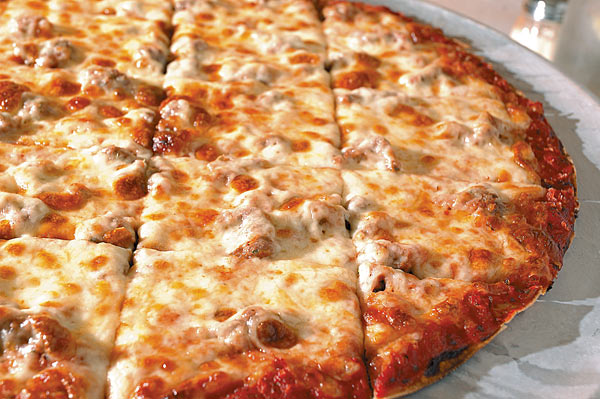
Chicago-style thin-crust pizza known in the Chicago area as a "Tavern Pizza", has a thinner crust than Chicago-style deep dish, and is baked flat rather than in a deep dish pan. The crust is thin and firm enough to have a noticeable crunch, unlike a New York-style pizza, yet thick enough to be soft and doughy on the top. The crust is invariably topped with a liberal quantity of southern-Italian style tomato sauce, which is usually quite herbal or highly spiced, and typically contains no visible chunks of tomato. Next, a layer of toppings is added, and a layer of mozzarella cheese which frequently separates from the bottom crust due to the quantity of tomato sauce. Chicago-style thin crust pizzas are cut into three-to-four-inch (8–10 cm) squares, also known as "party cut", as opposed to a "pie cut" into wedges. Chicago-style thin crust pizza is prevalent throughout the Midwestern US.

Detroit-style pizza is also known as Sicilian Square Pizza.[1] It is a square pizza, with a thick deep-dish crust with toppings placed under the sauce.

Quad City-style pizza is a thin crusted dough that has a “spice mix” that is heavy on malt which lends a toasted, nutty flavor. The sauce contains both red chile flakes and ground cayenne, the smooth, thin tomato spread is more spicy than sweet. The sausage is a thick blanket of lean, fennel-flecked Italian sausage that’s ground twice and spread from edge to edge.

St. Louis-style pizza is a variant of Chicago-style thin crust that is popular around St. Louis, Missouri and southern Illinois. The most notable characteristic of St. Louis-style pizza is the distinctive Provel cheese used instead of (or rarely in addition to) the mozzarella common to Chicago-style thin crust. The toppings are usually sliced instead of diced. If ordered with sausage or hamburger, the meat is squeezed off by hand into marble-sized chunks. The crust is thin enough that it becomes very crunchy in the oven and is sometimes compared to a cracker. Even though the crust is round, it is always cut into small squares.

Greek pizza is a variation popular in New England; its name comes from it being typical of the style of pizzerias owned by Greek immigrants. It has a thicker, chewier crust and is baked in a pan in the pizza oven, instead of directly on the bricks. Plain olive oil is a common part of the topping, as well as being liberally used to grease the pans and crisp the crust. Variations in other parts of the country include using feta cheese, Kalamata olives, and Greek herbs such as oregano.

Hawaiian pizza has Canadian bacon (or sliced ham) and/or bacon with pineapple toppings with Mozzarella cheese. This type of pizza is especially popular in the western United States, and is also a popular topping combination in Australia, Canada, and Sweden, but notably not in Hawaii. This type is also common within the EU, where it is known as pizza Hawaii.
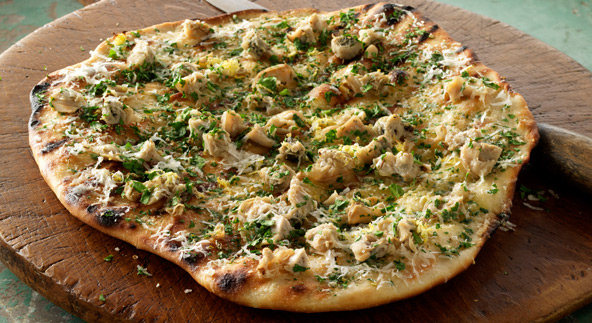
New Haven-style pizza, also known as apizza, is popular in Connecticut. It has a thin crust that varies between chewy and tender, depending on the particular establishment. The default version is a "white" pizza topped with only garlic and hard cheeses; customers who want tomato sauce or mozzarella cheese have to ask for them explicitly. Apizza has a very dark, "scorched" crisp crust that offers a distinctive bitter flavor, which can be offset by the sweetness of tomatoes or other toppings. New Haven-style pizza is traditionally cooked in brick ovens.

New York-style pizza is a style originally developed in New York City by immigrants from Naples, where pizza was created. It is often sold in generously sized, thin and flexible slices. It is traditionally hand-tossed, moderate on sauce, and moderately covered with cheese essentially amounting to a much larger version of the Neapolitan style. The slices are sometimes eaten folded in half, or even stacked, as its size and flexibility may otherwise make it unwieldy to eat by hand. This style of pizza tends to dominate the Northeastern states, and is very similar to the basic style common through the United States and known simply as pizza. Many pizza establishments in the New York metropolitan area offer two varieties of pizza: "Neapolitan", or "regular", made with a relatively thin, circular crust and served in wedge-shaped slices, and "Sicilian", or "square", made with a thicker, rectangular crust and served in large, rectangular slices. Another type of pizza, popular on Long Island as well as the five boroughs, is Grandma pizza. It is cooked in a square pan like Sicilian, but it is much thinner. It has a thin, crispy crust, usually has tomato chunks in addition, or in exception, to the sauce. Generally, it will contain less cheese than regular slices, and sometimes has extra spices or oils baked into the crust.

Old Forge style pizza is typically rectangular in shape with a balanced tangy sauce, and topped with a creamier cheese, similar to fontina or white American, on a crispy thicker crust. Old Forge style pizza is served at many restaurants in Northeastern Pennsylvania and as far away as Michigan, Florida, and Colorado.
What now?
Talk about pizza.
Post pictures of pizza.
Share pizza recipes.
Enjoy!
Pizza in its most basic form as a seasoned flatbread has a long history in the Mediterranean. Several cultures including the Greeks and Phoenicians ate a flatbread made from flour and water. The dough would be cooked by placing on a hot stone and then seasoned with herbs. The Greeks called this early pizza plankuntos and it was basically used as an edible plate when eating stews or thick broth. It was not yet what we would call pizza today but it was very much like modern focaccia. These early pizzas were eaten from Rome to Egypt to Babylon and were praised by the ancient historians Herodotus and Cato the Elder.
The introduction of tomatoes to Italian cuisine in the 18th and early 19th centuries finally gave us the true modern Italian pizza. Even though tomatoes reached Italy by the 1530's it was widely thought that they were poisonous and were grown only for decoration. However the innovative (and probably starving) peasants of Naples started using the supposedly deadly fruit in many of their foods, including their early pizzas. Since that fateful day the world of Italian cuisine would never be the same, however it took some time for the rest of society to accept this crude peasant food. Once members of the local aristocracy tried pizza they couldn't get enough of it, which by this time was being sold on the streets of Naples for every meal. As pizza popularity increased, street vendors gave way to actual shops where people could order a custom pizza with many different toppings. By 1830 the "Antica Pizzeria Port'Alba" of Naples had become the first true pizzeria and this venerable institution is still producing masterpieces.
Thanks to http://www.lifeinitaly.com/
Pizza, pizza, pizza - so much pizza!
Pizza is one of the most versatile foods out there, in addition to a near infinite combination of toppings, sauces, and cheeses - there are even different types of doughs and compositions:
Italian pizzas
Neapolitan pizza

Neapolitan pizza (pizza napoletana): Authentic Neapolitan pizzas are typically made with tomatoes and Mozzarella cheese. They can be made with ingredients like San Marzano tomatoes, which grow on the volcanic plains to the south of Mount Vesuvius, and mozzarella di bufala Campana, made with the milk from water buffalo raised in the marshlands of Campania and Lazio in a semi-wild state (this mozzarella is protected with its own European protected designation of origin).
Lazio style
Pizza al taglio

Pizza Rustica
Pizza in Lazio (Rome), as well as in many other parts of Italy, is available in two different styles. Take-away shops sell pizza rustica or pizza al taglio. This pizza is cooked in long, rectangular baking pans and relatively thick (1–2 cm). The pizza is often cooked in an electric oven. It is usually cut with scissors or a knife and sold by weight. In pizzerias, pizza is served in a dish in its traditional round shape. It has a thin, crisp base quite different from the thicker and softer Neapolitan style base. It is usually cooked in a wood-fired oven, giving the pizza its unique flavor and texture.
German pizzas
Flammkuchen

Flammekueche or Tarte flambée is an Alsatian dish composed of bread dough rolled out very thin in the shape of a rectangle (traditionally) or circle, which is covered with fromage blanc or crème fraîche, thinly sliced onions and lardons. It is one of the most famous gastronomical specialties of the region.
Brazilian pizzas
Pizza com catupiry

This pizza is unique to Brazil and "Catupiry", a type of creamy cheese, on the pizza.
Korea
Grand Prix

Korean-style pizza tends to be complicated, and often has nontraditional toppings such as corn, potato wedges, sweet potato, shrimp, or crab. The super-deluxe "Grand Prix" at Mr. Pizza has Cajun shrimp, bell peppers, olives, and mushrooms on one side, and potato wedges, bacon, crushed tortilla chips, and sour cream on the other side. Its potato mousse-filled cookie dough crust is sprinkled with sunflower seeds, pumpkin seeds, and raisins, and can be dipped in a blueberry sauce that is provided.
Sweden
Doner Kebab Pizza

One of the most popular types of pizza in Sweden is kebab-pizza, with doner kebab as the main topping. The typical side order with Swedish pizza is a pizza salad made with shredded cabbage and sometimes red pepper that's been slightly pickled in vinaigrette for a few days. The pizza is often slathered with a yoghurt-based sauce as well as a red, spicy sauce.
U.S.A Pizzas
Due to the wide influence of Italian immigrants in American culture, the US has developed regional forms of pizza, that I feel needs a section of its own to go through:

Shallots and olive oil california-style pizza
California-style pizza refers to pizza with non-traditional ingredients, especially those that use a considerable amount of fresh produce. A Thai-inspired chicken pizza with peanut sauce, bean sprouts, and shaved carrots is a popular variant in California-style pizza restaurants, as are taco pizzas, and pizzas that use chicken and barbecue sauce as toppings.

Chicago-style pizza, or Chicago-style deep-dish pizza, contains a crust which is formed up the sides of a deep-dish pan. It reverses the order of some ingredients, using crust, cheese, filling, then sauce on top. Some versions (usually referred to as stuffed) have two layers of crust with the sauce on top. The invention of deep-dish pizza occurred in America and transcends a single ethnic origin. Deep-dish pizza was invented by Ike Sewell and Ric Riccardo and first served in 1943 at Pizzeria Uno, which is still operating along with its twin restaurant, Pizzeria Due, in the River North neighborhood.

Chicago-style thin-crust pizza known in the Chicago area as a "Tavern Pizza", has a thinner crust than Chicago-style deep dish, and is baked flat rather than in a deep dish pan. The crust is thin and firm enough to have a noticeable crunch, unlike a New York-style pizza, yet thick enough to be soft and doughy on the top. The crust is invariably topped with a liberal quantity of southern-Italian style tomato sauce, which is usually quite herbal or highly spiced, and typically contains no visible chunks of tomato. Next, a layer of toppings is added, and a layer of mozzarella cheese which frequently separates from the bottom crust due to the quantity of tomato sauce. Chicago-style thin crust pizzas are cut into three-to-four-inch (8–10 cm) squares, also known as "party cut", as opposed to a "pie cut" into wedges. Chicago-style thin crust pizza is prevalent throughout the Midwestern US.

Detroit-style pizza is also known as Sicilian Square Pizza.[1] It is a square pizza, with a thick deep-dish crust with toppings placed under the sauce.

Quad City-style pizza is a thin crusted dough that has a “spice mix” that is heavy on malt which lends a toasted, nutty flavor. The sauce contains both red chile flakes and ground cayenne, the smooth, thin tomato spread is more spicy than sweet. The sausage is a thick blanket of lean, fennel-flecked Italian sausage that’s ground twice and spread from edge to edge.

St. Louis-style pizza is a variant of Chicago-style thin crust that is popular around St. Louis, Missouri and southern Illinois. The most notable characteristic of St. Louis-style pizza is the distinctive Provel cheese used instead of (or rarely in addition to) the mozzarella common to Chicago-style thin crust. The toppings are usually sliced instead of diced. If ordered with sausage or hamburger, the meat is squeezed off by hand into marble-sized chunks. The crust is thin enough that it becomes very crunchy in the oven and is sometimes compared to a cracker. Even though the crust is round, it is always cut into small squares.

Greek pizza is a variation popular in New England; its name comes from it being typical of the style of pizzerias owned by Greek immigrants. It has a thicker, chewier crust and is baked in a pan in the pizza oven, instead of directly on the bricks. Plain olive oil is a common part of the topping, as well as being liberally used to grease the pans and crisp the crust. Variations in other parts of the country include using feta cheese, Kalamata olives, and Greek herbs such as oregano.

Hawaiian pizza has Canadian bacon (or sliced ham) and/or bacon with pineapple toppings with Mozzarella cheese. This type of pizza is especially popular in the western United States, and is also a popular topping combination in Australia, Canada, and Sweden, but notably not in Hawaii. This type is also common within the EU, where it is known as pizza Hawaii.

New Haven-style pizza, also known as apizza, is popular in Connecticut. It has a thin crust that varies between chewy and tender, depending on the particular establishment. The default version is a "white" pizza topped with only garlic and hard cheeses; customers who want tomato sauce or mozzarella cheese have to ask for them explicitly. Apizza has a very dark, "scorched" crisp crust that offers a distinctive bitter flavor, which can be offset by the sweetness of tomatoes or other toppings. New Haven-style pizza is traditionally cooked in brick ovens.

New York-style pizza is a style originally developed in New York City by immigrants from Naples, where pizza was created. It is often sold in generously sized, thin and flexible slices. It is traditionally hand-tossed, moderate on sauce, and moderately covered with cheese essentially amounting to a much larger version of the Neapolitan style. The slices are sometimes eaten folded in half, or even stacked, as its size and flexibility may otherwise make it unwieldy to eat by hand. This style of pizza tends to dominate the Northeastern states, and is very similar to the basic style common through the United States and known simply as pizza. Many pizza establishments in the New York metropolitan area offer two varieties of pizza: "Neapolitan", or "regular", made with a relatively thin, circular crust and served in wedge-shaped slices, and "Sicilian", or "square", made with a thicker, rectangular crust and served in large, rectangular slices. Another type of pizza, popular on Long Island as well as the five boroughs, is Grandma pizza. It is cooked in a square pan like Sicilian, but it is much thinner. It has a thin, crispy crust, usually has tomato chunks in addition, or in exception, to the sauce. Generally, it will contain less cheese than regular slices, and sometimes has extra spices or oils baked into the crust.

Old Forge style pizza is typically rectangular in shape with a balanced tangy sauce, and topped with a creamier cheese, similar to fontina or white American, on a crispy thicker crust. Old Forge style pizza is served at many restaurants in Northeastern Pennsylvania and as far away as Michigan, Florida, and Colorado.
What now?
Talk about pizza.
Post pictures of pizza.
Share pizza recipes.
Enjoy!






